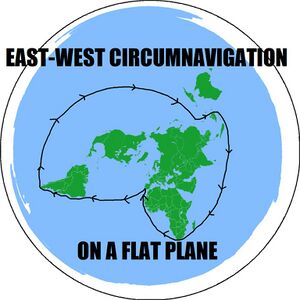Difference between revisions of "Frequently Asked Questions"
| Line 40: | Line 40: | ||
<div class="toccolours mw-collapsible-content">A: The first presupposition that needs to be discarded before this question can be properly answered is the [https://www.youtube.com/watch?v=1rdvjsqD8BE unverifiable pseudoscientific fairy tale] that the sun is located 93 million miles away from the Earth. This number is based on calculations that assume the R value of the Earth or the distance from the Earth to moon or the circular reasoning required in order to depend upon the phenomenon of parallax. Actual observations of the sun and the way that light falls upon the Earth indicate that the sun is much closer. This concept is explained well in Chapter 7 of the book [https://archive.org/details/kingsdethronedhi00hickrich/page/32/mode/2up?q=parallax Kings Dethroned]. | <div class="toccolours mw-collapsible-content">A: The first presupposition that needs to be discarded before this question can be properly answered is the [https://www.youtube.com/watch?v=1rdvjsqD8BE unverifiable pseudoscientific fairy tale] that the sun is located 93 million miles away from the Earth. This number is based on calculations that assume the R value of the Earth or the distance from the Earth to moon or the circular reasoning required in order to depend upon the phenomenon of parallax. Actual observations of the sun and the way that light falls upon the Earth indicate that the sun is much closer. This concept is explained well in Chapter 7 of the book [https://archive.org/details/kingsdethronedhi00hickrich/page/32/mode/2up?q=parallax Kings Dethroned]. | ||
| − | When we leave these presuppositions behind, what we actually observe on Earth is that the sun illuminates different parts of the plane at different times. If you take a flashlight and point it at your bedroom floor at night, it only illuminates one part of the carpet at a time, and the rest of the floor is in shadow. In the same way, a close and local | + | When we leave these presuppositions behind, what we actually observe on Earth is that the sun illuminates different parts of the plane at different times. If you take a flashlight and point it at your bedroom floor at night, it only illuminates one part of the carpet at a time, and the rest of the floor is in shadow. In the same way, a close and local sun circling overhead would only illuminate one part of the world before moving on to another part. Here is a possible demonstration of how that might look, based on what we actually observe: [https://tenor.com/view/flatearth-gif-8521428 Demonstration of Sun's Partial Illumination of a Flat Plane] The globe model requires complicated mathematical calculations based on inaccurate numbers and presuppositions. Indeed it is much more difficult to explain the path of the sun when using the hypothetical globe model than it is to explain the reality of what we observe on a flat and stationary Earth. |
<youtube>https://www.youtube.com/watch?v=b_ppPXChyTo&t=41s</youtube> | <youtube>https://www.youtube.com/watch?v=b_ppPXChyTo&t=41s</youtube> | ||
Revision as of 17:09, 12 March 2021
Q: If the Earth is not spherical, why do boats disappear over the horizon?
A: [coming soon]
Q: Didn't Eratosthenes use sticks and shadows to prove that the Earth is ball-shaped?
A: [coming soon]
When we leave these presuppositions behind, what we actually observe on Earth is that the sun illuminates different parts of the plane at different times. If you take a flashlight and point it at your bedroom floor at night, it only illuminates one part of the carpet at a time, and the rest of the floor is in shadow. In the same way, a close and local sun circling overhead would only illuminate one part of the world before moving on to another part. Here is a possible demonstration of how that might look, based on what we actually observe: Demonstration of Sun's Partial Illumination of a Flat Plane The globe model requires complicated mathematical calculations based on inaccurate numbers and presuppositions. Indeed it is much more difficult to explain the path of the sun when using the hypothetical globe model than it is to explain the reality of what we observe on a flat and stationary Earth.
read more ...
Q: How do you have time zones without the globe model?
A: [coming soon]
Q: If the Earth measures flat, why can't we see forever?
A: [coming soon]
Q: Does gravity exist?
A: [coming soon]
Q: Don't eclipses prove the globe?
A: [coming soon]
Q: If the Earth is flat, how do you explain the Coriolis effect?
A: [coming soon]
Q: Why is Earth the only flat planet?
A: [coming soon]
Q: What is underneath the Earth?
A: [coming soon]
Q: Why would they lie?
A: [coming soon]


